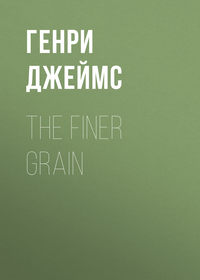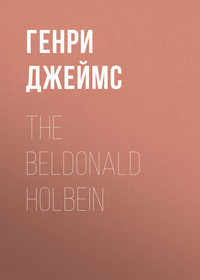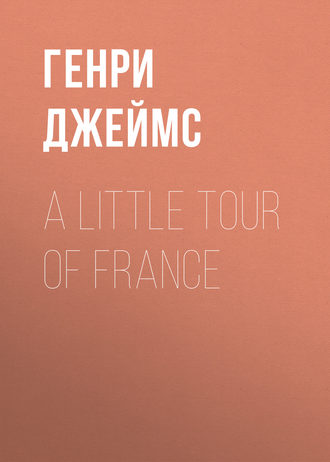 полная версия
полная версияA Little Tour of France
I ought perhaps to be ashamed to acknowledge that I found the profane name of Balzac capable of adding an interest even to this venerable sanctuary. Those who have read the terrible little story of "Le Curé de Tours" will perhaps remember that, as I have already mentioned, the simple and childlike old Abbé Birotteau, victim of the infernal machinations of the Abbé Troubert and Mademoiselle Gamard, had his quarters in the house of that lady (she had a specialty of letting lodgings to priests), which stood on the north side of the cathedral, so close under its walls that the supporting pillar of one of the great flying buttresses was planted in the spinster's garden. If you wander round behind the church in search of this more than historic habitation you will have occasion to see that the side and rear of Saint Gatien make a delectable and curious figure. A narrow lane passes beside the high wall which conceals from sight the palace of the archbishop and beneath the flying buttresses, the far-projecting gargoyles, and the fine south porch of the church. It terminates in a little dead grass-grown square entitled the Place Grégoire de Tours. All this part of the exterior of the cathedral is very brown, ancient, Gothic, grotesque; Balzac calls the whole place "a desert of stone." A battered and gabled wing or out-house (as it appears to be) of the hidden palace, with a queer old stone pulpit jutting out from it, looks down on this melancholy spot, on the other side of which is a seminary for young priests, one of whom issues from a door in a quiet corner, and, holding it open a moment behind him, shows a glimpse of a sunny garden, where you may fancy other black young figures strolling up and down. Mademoiselle Gamard's house, where she took her two abbés to board, and basely conspired with one against the other, is still farther round the cathedral. You cannot quite put your hand upon it to-day, for the dwelling of which you say to yourself that it must have been Mademoiselle Gamard's does not fulfil all the conditions mentioned in Balzac's description. The edifice in question, however, fulfils conditions enough; in particular, its little court offers hospitality to the big buttress of the church. Another buttress, corresponding with this (the two, between them, sustain the gable of the north transept), is planted in the small cloister, of which the door on the farther side of the little soundless Rue de la Psalette, where nothing seems ever to pass, opens opposite to that of Mademoiselle Gamard. There is a very genial old sacristan, who introduced me to this cloister from the church. It is very small and solitary, and much mutilated; but it nestles with a kind of wasted friendliness beneath the big walls of the cathedral. Its lower arcades have been closed, and it has a small plot of garden in the middle, with fruit-trees which I should imagine to be too much overshadowed. In one corner is a remarkably picturesque turret, the cage of a winding staircase which ascends (no great distance) to an upper gallery, where an old priest, the chanoine-gardien of the church, was walking to and fro with his breviary. The turret, the gallery, and even the chanoine-gardien, belonged, that sweet September morning, to the class of objects that are dear to painters in water-colours.

TOURS—THE CATHEDRAL
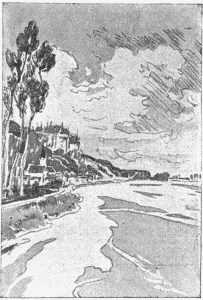
Chapter iii
Tours: Saint MartinI HAVE mentioned the church of Saint Martin, which was for many years the sacred spot, the shrine of pilgrimage, of Tours. Originally the simple burial-place of the great apostle who in the fourth century Christianised Gaul and who, in his day a brilliant missionary and worker of miracles, is chiefly known to modern fame as the worthy that cut his cloak in two at the gate of Amiens to share it with a beggar (tradition fails to say, I believe, what he did with the other half), the abbey of Saint Martin, through the Middle Ages, waxed rich and powerful, till it was known at last as one of the most luxurious religious houses in Christendom, with kings for its titular abbots (who, like Francis I., sometimes turned and despoiled it) and a great treasure of precious things. It passed, however, through many vicissitudes. Pillaged by the Normans in the ninth century and by the Huguenots in the sixteenth, it received its death-blow from the Revolution, which must have brought to bear upon it an energy of destruction proportionate to its mighty bulk. At the end of the last century a huge group of ruins alone remained, and what we see to-day may be called the ruin of a ruin. It is difficult to understand how so vast an edifice can have been so completely obliterated. Its site is given up to several ugly streets, and a pair of tall towers, separated by a space which speaks volumes as to the size of the church and looking across the close-pressed roofs to the happier spires of the cathedral, preserve for the modern world the memory of a great fortune, a great abuse, perhaps, and at all events a great penalty. One may believe that to this day a considerable part of the foundations of the great abbey is buried in the soil of Tours. The two surviving towers, which are dissimilar in shape, are enormous; with those of the cathedral they form the great landmarks of the town. One of them bears the name of the Tour de l'Horloge; the other, the so-called Tour Charlemagne, was erected (two centuries after her death) over the tomb of Luitgarde, wife of the great Emperor, who died at Tours in 800. I do not pretend to understand in what relation these very mighty and effectually detached masses of masonry stood to each other, but in their grey elevation and loneliness they are striking and suggestive to-day; holding their hoary heads far above the modern life of the town and looking sad and conscious, as they had outlived all uses. I know not what is supposed to have become of the bones of the blessed saint during the various scenes of confusion in which they may have got mislaid; but a mystic connection with his wonder-working relics may be perceived in a strange little sanctuary on the left of the street, which opens in front of the Tour Charlemagne—whose immemorial base, by the way, inhabited like a cavern, with a diminutive doorway where, as I passed, an old woman stood cleaning a pot, and a little dark window decorated with homely flowers, would be appreciated by a painter in search of "bits." The present shrine of Saint Martin is enclosed (provisionally, I suppose) in a very modern structure of timber, where in a dusky cellar, to which you descend by a wooden staircase adorned with votive tablets and paper roses, is placed a tabernacle surrounded by twinkling tapers and prostrate worshippers. Even this crepuscular vault, however, fails, I think, to attain solemnity; for the whole place is strangely vulgar and garish. The Catholic Church, as churches go to-day, is certainly the most spectacular; but it must feel that it has a great fund of impressiveness to draw upon when it opens such sordid little shops of sanctity as this. It is impossible not to be struck with the grotesqueness of such an establishment as the last link in the chain of a great ecclesiastical tradition.
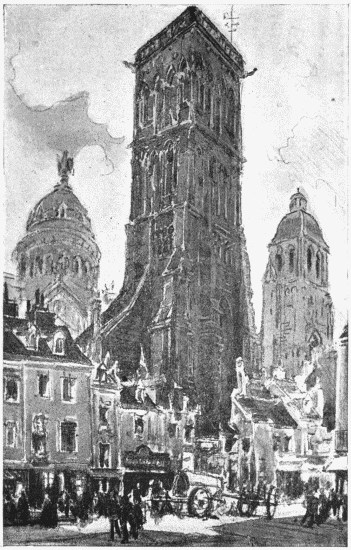
TOURS—THE TOWERS OF ST. MARTIN
In the same street, on the other side, a little below, is something better worth your visit than the shrine of Saint Martin. Knock at a high door in a white wall (there is a cross above it), and a fresh-faced sister of the convent of the Petit Saint Martin will let you into the charming little cloister, or rather fragment of cloister. Only one side of this surpassing structure remains, but the whole place is effective. In front of the beautiful arcade, which is terribly bruised and obliterated, is one of those walks of interlaced tilleuls which are so frequent in Touraine, and into which the green light filters so softly through a lattice of clipped twigs. Beyond this is a garden, and beyond the garden are the other buildings of the convent, where the placid sisters keep a school—a test, doubtless, of placidity. The imperfect arcade, which dates from the beginning of the sixteenth century (I know nothing of it but what is related in Mrs. Pattison's "Renaissance in France"), is a truly enchanting piece of work; the cornice and the angles of the arches being covered with the daintiest sculpture of arabesques, flowers, fruit, medallions, cherubs, griffins, all in the finest and most attenuated relief. It is like the chasing of a bracelet in stone. The taste, the fancy, the elegance, the refinement, are of the order that straightens up again our drooping standard of distinction. Such a piece of work is the purest flower of the French Renaissance; there is nothing more delicate in all Touraine.
There is another fine thing at Tours which is not particularly delicate, but which makes a great impression—the very interesting old church of Saint Julian, lurking in a crooked corner at the right of the Rue Royale, near the point at which this indifferent thoroughfare emerges, with its little cry of admiration, on the bank of the Loire. Saint Julian stands to-day in a kind of neglected hollow, where it is much shut in by houses; but in the year 1225, when the edifice was begun, the site was doubtless, as the architects say, more eligible. At present indeed, when once you have caught a glimpse of the stout, serious Romanesque tower—which is not high, but strong—you feel that the building has something to say and that you must stop to listen to it. Within, it has a vast and splendid nave, of immense height, the nave of a cathedral, with a shallow choir and transepts and some admirable old glass. I spent half an hour there one morning, listening to what the church had to say, in perfect solitude. Not a worshipper entered, not even an old man with a broom. I have always thought there be a sex in fine buildings; and Saint Julian, with its noble nave, is of the gender of the name of its patron.
It was that same morning, I think, that I went in search of the old houses of Tours; for the town contains several goodly specimens of the domestic architecture of the past. The dwelling to which the average Anglo-Saxon will most promptly direct his steps, and the only one I have space to mention, is the so-called Maison de Tristan l'Hermite—a gentleman whom the readers of "Quentin Durward" will not have forgotten—the hangman-in-ordinary to that great and prompt chastener Louis XI. Unfortunately the house of Tristan is not the house of Tristan at all; this illusion has been cruelly dispelled. There are no illusions left at all, in the good city of Tours, with regard to Louis XI. His terrible castle of Plessis, the picture of which sends a shiver through the youthful reader of Scott, has been reduced to suburban insignificance; and the residence of his triste compère, on the front of which a festooned rope figures as a motive for decoration, is observed to have been erected in the succeeding century. The Maison de Tristan may be visited for itself, however, if not for Sir Walter; it is an exceedingly picturesque old façade, to which you pick your way through a narrow and tortuous street—a street terminating, a little beyond it, in the walk beside the river. An elegant Gothic doorway is let into the rusty-red brickwork, and strange little beasts crouch at the angles of the windows, which are surmounted by a tall graduated gable, pierced with a small orifice, where the large surface of brick, lifted out of the shadow of the street, looks yellow and faded. The whole thing is disfigured and decayed; but it is a capital subject for a sketch in colours. Only I must wish the sketcher better luck—or a better temper—than my own. If he ring the bell to be admitted to see the court, which I believe is more sketchable still, let him have patience to wait till the bell is answered. He can do the outside while they are coming.
The Maison de Tristan, I say, may be visited for itself; but I hardly know for what the remnants of Plessis-les-Tours may be investigated. To reach them you wander through crooked suburban lanes, down the course of the Loire, to a rough, undesirable, incongruous spot, where a small, crude building of red brick is pointed out to you by your cabman (if you happen to drive) as the legendary frame of the grim portrait, and where a strong odour of pigsties and other unclean things so prostrates you for the moment that you have no energy to protest against this obvious fiction. You enter a yard encumbered with rubbish and a defiant dog, and an old woman emerges from a shabby lodge and assures you that you stand deep in historic dust. The red brick building, which looks like a small factory, rises on the ruins of the favourite residence of the dreadful Louis. It is now occupied by a company of night-scavengers, whose huge carts are drawn up in a row before it. I know not whether this be what is called the irony of fate; in any case, the effect of it is to accentuate strongly the fact (and through the most susceptible of our senses) that there is no honour for the authors of great wrongs. The dreadful Louis is reduced simply to an offence to the nostrils. The old woman shows you a few fragments—several dark, damp, much-encumbered vaults, denominated dungeons, and an old tower staircase in good condition. There are the outlines of the old moat; there is also the outline of the old guard-room, which is now a stable; and there are other silhouettes of the undistinguishable, which I have forgotten. You need all your imagination, and even then you cannot make out that Plessis was a castle of large extent, though the old woman, as your eye wanders over the neighbouring potagers, discourses much of the gardens and the park. The place looks mean and flat; and as you drive away you scarcely know whether to be glad or sorry that all those bristling horrors have been reduced to the commonplace.
A certain flatness of impression awaits you also, I think, at Marmoutier, which is the other indispensable excursion in the near neighbourhood of Tours. The remains of this famous abbey lie on the other bank of the stream, about a mile and a half from the town. You follow the edge of the big brown river; of a fine afternoon you will be glad to go farther still. The abbey has gone the way of most abbeys; but the place is a restoration as well as a ruin, inasmuch as the Sisters of the Sacred Heart have erected a terribly modern convent here. A large Gothic doorway, in a high fragment of ancient wall, admits you to a garden-like enclosure, of great extent, from which you are further introduced into an extraordinarily tidy little parlour, where two good nuns sit at work. One of these came out with me and showed me over the place—a very definite little woman, with pointed features, an intensely distinct enunciation, and those pretty manners which (for whatever other teachings it may be responsible) the Catholic Church so often instils into its functionaries. I have never seen a woman who had got her lesson better than this little trotting, murmuring, edifying nun. The interest of Marmoutier to-day is not so much an interest of vision, so to speak, as an interest of reflection—that is, if you choose to reflect (for instance) upon the wondrous legend of the seven sleepers (you may see where they lie in a row), who lived together—they were brothers and cousins—in primitive piety, in the sanctuary constructed by the blessed Saint Martin (emulous of his precursor, Saint Gatianus), in the face of the hillside that overhung the Loire, and who, twenty-five years after his death, yielded up their seven souls at the same moment and enjoyed the rare convenience of retaining in their faces, in spite of mortality, every aspect of health. The abbey of Marmoutier, which sprang from the grottos in the cliff to which Saint Gatianus and Saint Martin retired to pray, was therefore the creation of the latter worthy, as the other great abbey, in the town proper, was the monument of his repose. The cliff is still there; and a winding staircase, in the latest taste, enables you conveniently to explore its recesses. These sacred niches are scooped out of the rock, and will give you an impression if you cannot do without one. You will feel them to be sufficiently venerable when you learn that the particular pigeon-hole of Saint Gatianus, the first Christian missionary to Gaul, dates from the third century. They have been dealt with as the Catholic Church deals with most of such places to-day; polished and furbished up, labelled and ticketed—edited, with notes, in short, like an old book. The process is a mistake—the early editions had more sanctity. The modern buildings (of the Sacred Heart), on which you look down from these points of vantage, are in the vulgar taste which sets its so mechanical stamp on all new Catholic work; but there was nevertheless a great sweetness in the scene. The afternoon was lovely, and it was flushing to a close. The large garden stretched beneath us, blooming with fruit and and wine and succulent promise, and beyond it flowed the shining river. The air was still, the shadows were long, and the place, after all, was full of memories, most of which might pass for virtuous. It certainly was better than Plessis-les-Tours.
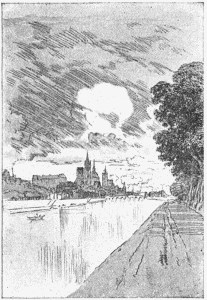
Chapter iv
BloisYOUR business at Tours is to make excursions; and if you make them all you will be always under arms. The land is a rich reliquary, and an hour's drive from the town in almost any direction will bring you to the knowledge of some curious fragment of domestic or ecclesiastical architecture, some turreted manor, some lonely tower, some gabled village, some scene of something. Yet even if you do everything—which was not my case—you cannot hope to tell everything, and, fortunately for you, the excursions divide themselves into the greater and the less. You may achieve most of the greater in a week or two; but a summer in Touraine (which, by the way, must be a delectable thing) would hold none too many days for the others. If you come down to Tours from Paris your best economy is to spend a few days at Blois, where a clumsy but rather attractive little inn on the edge of the river will offer you a certain amount of that familiar and intermittent hospitality which a few weeks spent in the French provinces teaches you to regard as the highest attainable form of accommodation. Such an economy I was unable to practise. I could only go to Blois (from Tours) to spend the day; but this feat I accomplished twice over. It is a very sympathetic little town, as we say nowadays, and a week there would be sociable even without company. Seated on the north bank of the Loire, it presents a bright, clean face to the sun and has that aspect of cheerful leisure which belongs to all white towns that reflect themselves in shining waters. It is the water-front only of Blois, however, that exhibits this fresh complexion; the interior is of a proper brownness, as old sallow books are bound in vellum. The only disappointment is perforce the discovery that the castle, which is the special object of one's pilgrimage, does not overhang the river, as I had always allowed myself to understand. It overhangs the town, but is scarcely visible from the stream. That peculiar good fortune is reserved for Amboise and Chaumont.
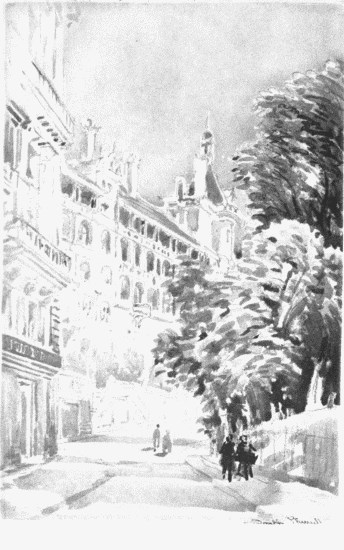
BLOIS
The Château de Blois is one of the most beautiful and elaborate of all the old royal residences of this part of France, and I suppose it should have all the honours of my description. As you cross its threshold you step straight into the sunshine and storm of the French Renaissance. But it is too rich to describe—I can only pick out the high lights. It must be premised that in speaking of it as we see it to-day we speak of a monument unsparingly restored. The work of restoration has been as ingenious as it is profuse, but it rather chills the imagination. This is perhaps almost the first thing you feel as you approach the castle from the streets of the town. These little streets, as they leave the river, have pretensions to romantic steepness; one of them, indeed, which resolves itself into a high staircase with divergent wings (the escalier monumental), achieved this result so successfully as to remind me vaguely—I hardly know why—of the great slope of the Capitol, beside the Ara Cœli, at Rome. The view of that part of the castle which figures to-day as the back (it is the only aspect I had seen reproduced) exhibits the marks of restoration with the greatest assurance. The long façade, consisting only of balconied windows deeply recessed, erects itself on the summit of a considerable hill, which gives a fine, plunging movement to its foundations. The deep niches of the windows are all aglow with colour. They have been repainted with red and blue, relieved with gold figures; and each of them looks more like the royal box at a theatre than like the aperture of a palace dark with memories. For all this, however, and in spite of the fact that, as in some others of the châteaux of Touraine (always excepting the colossal Chambord, which is not in Touraine), there is less vastness than one had expected, the least hospitable aspect of Blois is abundantly impressive. Here, as elsewhere, lightness and grace are the keynote; and the recesses of the windows, with their happy proportions, their sculpture and their colour, are the hollow sockets of the human ornament. They need the figure of a Francis I. to complete them, or of a Diane de Poitiers, or even of a Henry III. The stand of this empty gilt cage emerges from a bed of light verdure which has been allowed to mass itself there and which contributes to the springing look of the walls; while on the right it joins the most modern portion of the castle, the building erected, on foundations of enormous height and solidity, in 1635, by Gaston d'Orléans. This fine frigid mansion—the proper view of it is from the court within—is one of the masterpieces of François Mansard, whom a kind providence did not allow to make over the whole palace in the superior manner of his superior age. That had been a part of Gaston's plan—he was a blunderer born, and this precious project was worthy of him. This execution of it would surely have been one of the great misdeeds of history. Partially performed, the misdeed is not altogether to be regretted; for as one stands in the court of the castle and lets one's eye wander from the splendid wing of Francis I.—which is the last word of free and joyous invention—to the ruled lines and blank spaces of the ponderous pavilion of Mansard, one makes one's reflections upon the advantage, in even the least personal of the arts, of having something to say, and upon the stupidity of a taste which had ended by becoming an aggregation of negatives. Gaston's wing, taken by itself, has much of the bel air which was to belong to the architecture of Louis XIV.; but, taken in contrast to its flowering, laughing, living neighbour, it marks the difference between inspiration and calculation. We scarcely grudge it its place, however, for it adds a price to the rest of the pile.
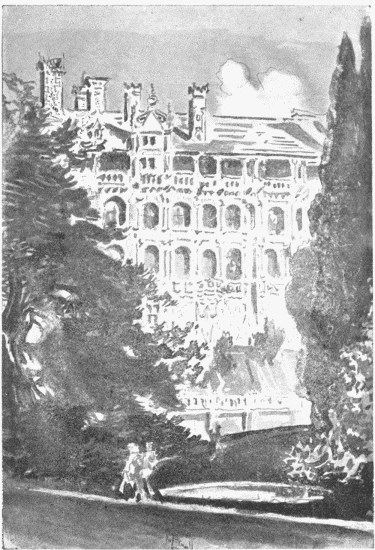
BLOIS—THE CHÂTEAU
We have entered the court, by the way, by jumping over the walls. The more orthodox method is to follow a modern terrace which leads to the left, from the side of the edifice that I began by speaking of, and passes round, ascending, to a little square on a considerably higher level, a square not, like the rather prosaic space on which the back (as I have called it) looks out, a thoroughfare. This small empty place, oblong in form, at once bright and quiet, and which ought to be grass-grown, offers an excellent setting to the entrance-front of the palace—the wing of Louis XII. The restoration here has been lavish; but it was perhaps but an inevitable reaction against the injuries, still more lavish, by which the unfortunate building had long been overwhelmed. It had fallen into a state of ruinous neglect, relieved only by the misuse proceeding from successive generations of soldiers, for whom its charming chambers served as barrack-room. Whitewashed, mutilated, dishonoured, the castle of Blois may be said to have escaped simply with its life. This is the history of Amboise as well, and is to a certain extent the history of Chambord. Delightful, at any rate, was the refreshed façade of Louis XII. as I stood and looked at it one bright September morning. In that soft, clear, merry light of Touraine, everything shows, everything speaks. Charming are the taste, the happy proportions, the colour of this beautiful front, to which the new feeling for a purely domestic architecture—an architecture of security and tranquillity, in which art could indulge itself—gave an air of youth and gladness. It is true that for a long time to come the castle of Blois was neither very safe nor very quiet; but its dangers came from within, from the evil passions of its inhabitants, and not from siege or invasion. The front of Louis XII. is of red brick, crossed here and there with purple; and the purple slate of the high roof, relieved with chimneys beautifully treated and with the embroidered caps of pinnacles and arches, with the porcupine of Louis, the ermine and the festooned rope which formed the devices of Anne of Brittany—the tone of this decorative roof carries out the mild glow of the wall. The wide, fair windows open as if they had expanded to let in the rosy dawn of the Renaissance. Charming, for that matter, are the windows of all the châteaux of Touraine, with their squareness corrected (as it is not in the Tudor architecture) by the curve of the upper corners, which gives this line the look, above the expressive aperture, of a pencilled eyebrow. The low door of this front is crowned by a high, deep niche, in which, under a splendid canopy, stiffly astride of a stiffly-draped charger, sits in profile an image of the good King Louis. Good as he had been—the father of his people, as he was called (I believe he remitted various taxes)—he was not good enough to pass muster at the Revolution; and the effigy I have just described is no more than a reproduction of the primitive statue demolished at that period.






